#i check for you in the wind
Text
your name written inside me.
Alejandra Pizarnik, The Galloping Hour: French Poems; from ‘I check for you in the wind’, tr. Patricio Ferrari & Forrest Gander
734 notes
·
View notes
Text
Me five minutes into any Zelda game:
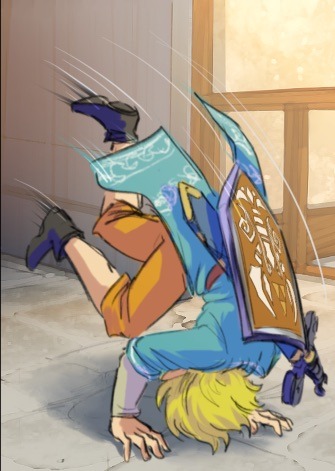
Credit to @linkeduniverse
#any Zelda game you can tumble in of course#it’s one of the first things I check when I start#yeah yeah that’s how you use the sword#but can I somersault?#that’s the important question#linked universe#linkeduniverse#lu wind#lu update spoilers#trin rambles
698 notes
·
View notes
Text

looks like SOMEBODY doesnt know about milo murphy's law
#phineas and ferb#candace against the universe#this is the thing right like yea catu happened but pnf never really left? like as soon as it was revealed in mml it was set in danville#it was like oh okay we're in the same universe so we're gonna see characters from pnf. and mml premiered like just over a year after pnf#ended so its like the gap wasnt even that huge#especially when you consider that there were probably bigger gaps between the pnf seasons themselves (not fact checked btw)#im just saying like there have been pretty big gaps between pnf episodes airing and especially toward the end when they were winding down#back to my main point though like people who havent deep dived into the dwampyverse have no clue. genuinely#like mml happened almost instantly. it was being made the same year pnf ended. it never needed a revival bc it never truly died in the#first place LIKEEEEEE#do you see what i mean#anyways#im very normal about this. i should actually write that analysis lol
68 notes
·
View notes
Note
pringle :]
(ima put this in every 3 sentence challenge inbox i can, so far its been you and uni >:3)
(Set in @skyloftian-nutcase’s healthcare AU :3)
“…Someone care to explain why Legend’s lying face down on the floor?” Warriors asks, raising his eyebrows as he enters the nurses’ break room.
“He went to get a snack but all they have is Pringles. He hates Pringles.”
A sorrowful moan rises up from the floor where Legend lays, and Warriors laughs.
#I HATE Pringles#they’re gross#so Legend gets to hate them too! :D#chimp you gremlin XD#imma have to check out Uni’s blog tho and see what she wrote for this 👀#lovely akchimp75#linked universe#linkeduniverse#lu legend#lu wind#lu warriors#writing game#plink plays a game#three sentence prompt#thank you for the ask! 🩷
47 notes
·
View notes
Text
a visual timeline of rain world's dated events, because it's 2 am and im autistic
Now, some important info. You will notice there are conventional dates in this visual; these are not canon but instead help us humans understand the ancients' ideas of time. A cycle is never given an explicit definition as a unit of time, so here we will equate the large number in the date, or the "cycle," to a typical Earth year. As for the decimals following that number, we will assume those function as typical decimals do.
So to demonstrate:
1543.067
Cycle or "year" 1543
0.067 of a year
0.067 × 365 = 24.455
approximately the 24-25th day of a year
Jan 24 (or 25) 1543
Again, these are not canon! They help make it easier for us to see the time between events.
And without further ado:


So, why is this important? I dont know honestly. But Ill share my takeaways because its my hyperfixation and Ill do what I want with it >:]
Unparalleled Innocence and Five Pebbles are the certified babies of the local group and likely are the same age-ish. My guess is that they had to have been around 50-70 cycles old when the Ascension happened. Babies!!
Sliver of Straw most definitely died before Five Pebbles came to be. Five Pebbles only learns about her secondhand through Seven Red Suns. He was not there to experience that event, which means the ancients were! Given that her methods remain unknown, the only ones who could've known how she died would be her citizens. However, that info shouldve spread. What likely happened? The ancients saw Sliver of Straw as a failure and decided to use Void Fluid anyway.
It is better to think of the iterator cans as "developments" or "neighborhoods" rather than cities, given how compact they are, and also how young they'd be compared to real-life metropolises! Meanwhile a neighborhood can appear and change drastically within a decade!
That being said, iterators can "live" a long time. Biocement already exists in real life, and the self-healing microbial colonies can remain dormant for around 200 years! However, water is one of the worst things for a building. These colonies will activate when a crack forms and exposes them to moisture. And since it's well...rain world: frequent erosion by rain and complete lack of maintenance severely reduces an iterator's lifespan as a structure.
Could the first generation of iterators be over 200 cycles old at the Ascension? Perhaps! But I think we severely underestimate the exponential rate of technological progress. Look at the last two centuries in our own world. Iterators in general have to be a lot younger than we think, as their infrastructure cannot last long.
So taking all of this into account...my estimate for the timeline of the whole game and not just the dated events? Can't be more than 400 cycles/years. The iterators are dying and theyre dying pretty damn fast. Id say even 400 is a generous number, as all of the "present" campaigns [Artificer to Rivulet] dont show much major change, save for the Rot. However again, that's speeding up Five Pebbles' decay.
Now Spearmaster seems surprisingly old. However it could be a result of them being artificial. But if that is indeed well within a slugcat's lifespan, that adds more credit to your shipping. Excluding Saint of course. Everyone is definitely dead by then.
All in all, I think we severely underestimate just how much can change within less than 400 years/cycles. Nature is very fast at reclamation, and in a world as volatile as Rain World? Even more so.
Anyway I someone out there has fun being a nerd like me Ive gotta go sleep for real now 🤙 lemme know your thoughts my brain needs stimulation
#rainworld#rain world#rw#rw downpour#rain world downpour#rain world iterator#rain world five pebbles#rain world lore#five pebbles#looks to the moon#does this even qualify as art#imma say no#too much effort went into this though#so i cant put it in my ramble tag#3 am oh shit#also suns is actually pretty ass???#why did they wait nearly 30 cycles before checking up on pebbs#and why did CHASING WIND have to be the one to remind them???????#maybe the friendship was fairly one sided??#srs you cant be srs
67 notes
·
View notes
Text


Is it just me or—does Aliquis’ brother look like he’s from Blueberry Academy? 👀✨✨✨
#fluff speaks !!!#first thing I thought of from seeing the blue uniforms and grid-like windows there#it would be super cool though imagine a single unique npc in the dlc just to reference the animated shorts#ALSO IF YOU MISSED IT THE NEW PALDEAN WINDS EPISODE DROPPED EARLIER GO CHECK IT OUT ✨✨✨✨✨#the animation is aaauauuUUOOOUUGGHHGG BREATHTAKING#paldean winds#pokemon scarvio#pokemon scarlet and violet#blueberry academy#aliquis#aliquis pokemon
26 notes
·
View notes
Text
American Presidents as Blind Dates
George Washington: The perfect 18th-century man--handsome, well-dressed, fantastic dancer, excellent horseback rider. Unfortunately, he's a gold-digger.
Thomas Jefferson: He'd be thrilling and charming as a first date, very engaging intellectually and socially. But if you got to know him better you might notice something kind of...off. A hidden selfishness and cruel streak.
James Monroe: Jury's out on whether he was good-looking or not, but he liked dancing and music and fine dining, so he'd probably be a decent date.
John Quincy Adams: Great conversationalist. Brilliant and he knows it. Irascible. Not much of a sense of humor.
Andrew Jackson: A perfect Southern gentleman who's very concerned about protecting the honor of a lady. (But if you happen to be an opponent, watch out).
Martin Van Buren: No one knows, because this guy was an enigma.
James K. Polk: Would talk about nothing but politics. (Happened to marry a woman who talked about nothing but politics, so it worked out okay).
James Buchanan: Big, loud, charming, loves dancing, tells jokes, and is probably gay.
Abraham Lincoln: Awkward with women and prefers to be one of the guys.
Ulysses S. Grant: Not a great first impression, because he doesn't care much about clothes and is pretty rumpled. (Writes adorable love letters, though).
Rutherford B. Hayes: Charismatic, loves people, loves going to cultural events. Will probably take you to a lecture.
James Garfield: Extremely outgoing. Big, booming laugh. As likely to give you a bear hug as a handshake.
Chester Arthur: Amazing blind date. He's handsome, impeccably-dressed, and his entire job is wining and dining people. (That makes him a terrible husband, though).
Grover Cleveland: If you met him at a public event, he'd seem very cold and distant. In private, he'd be warm and funny (and he's great at doing impressions).
Benjamin Harrison: Amazing guy to take home to your parents. Extremely respectable. Pretty boring as a date, though.
Theodore Roosevelt: So exuberant and energetic you might get overwhelmed. Will take you hiking, and if you run into obstacles, you have to climb over it rather than go around. You'd better have a lot of energy if you want to hang out with him.
#history is awesome#presidential talk#i was gonna work from memory but i did wind up checking some transcripts#and it turns out she didn't even ask the question for a bunch of the ones i didn't remember#she seems much more cagey about asking the question to men or really to anyone who doesn't work at the library of congress#(shoutout to the woman working at the rutherford b. hayes presidential library who immediately understood and loved the question)#(your enthusiasm for this president makes you one of the most charming guests on the podcast)#the only one i fudged was james garfield#because she asked about his level of extroversion rather than his blind date potential#but the answer seemed to fit the personality side of the blind date question so i went with it#anyway i can see where the question can seem kind of weird but it's such a fun way to talk about the personality of these presidents#and i was appalled when the host mentioned that some people wanted her to drop it#do these people have no sense of humor?#this is an excellent way to learn history
53 notes
·
View notes
Text
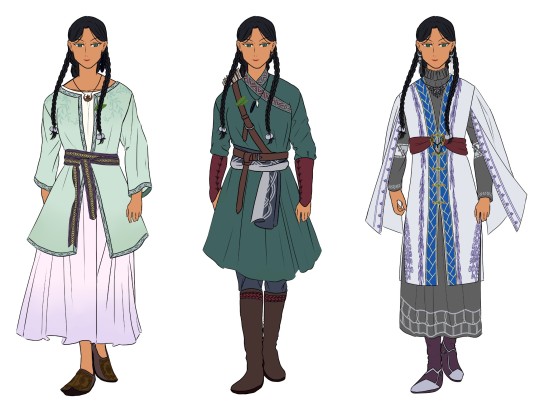

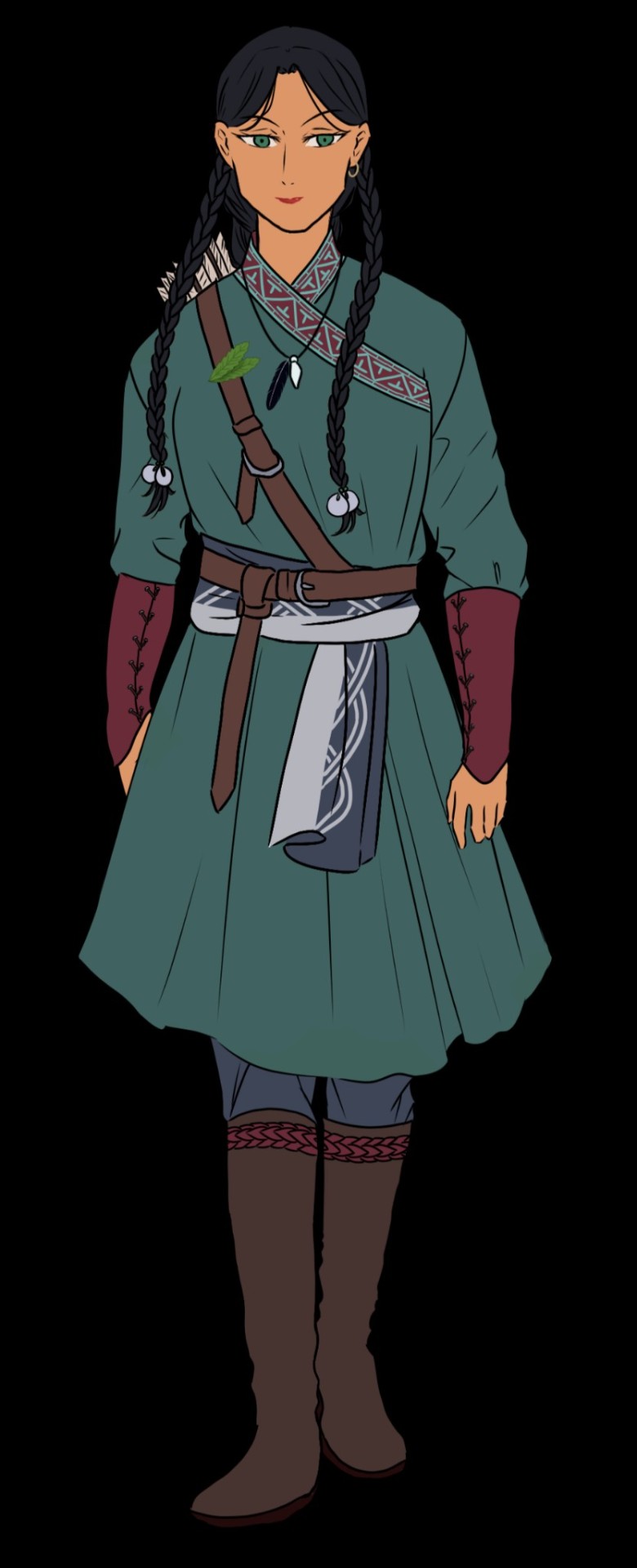

Aaaaand fellas here we have Farangis' designs!! Took a while, mostly bc med school is a bitch and drained all my spoons while I was working on her T_T
Strap your seatbelts, lads! We're going on a Journey™!
The first outfit is one that basically communicates her status as a healer the most. White, light purple, and light green are basically the main colours I associate with her as a character, and I'm very pleased with how this one turned out. (Those were supposed to be pants but I think I made them way too baggy and now it looks like a skirt, whoopsies)
Those are supposed to be willow branches on her coat, but it's kinda debatable how much I succeeded on that front, and since willow makes a repeat appearance in her ceremonial garb, I will save the symbolism for that part.
For now, though, it's sort of unnoticeable due to her hair colour, but she is wearing an earring made from a raven feather! And wouldn't you know it, there's a symbolic reason for that!
Aside from being her familiar animals, ravens can represent death, the afterlife, wisdom, intelligence, adaptability, prescience, fortune, destiny, transformation, and the future. Their symbolism is both positive and negative, and they’re seen as both good and bad omens. Here's a few associations I picked up for Farangis:
“The raven symbolizes prophecy, insight, transformation, intelligence, and mystery. They can also represent wise people who bring messages to those around them. The raven also symbolizes recovery and healing.”
Farangis is a wise person who advises the people around her, both in this AU and in canon— and her proficiency with the art of healing is particularly well-suited to the raven's symbolism. Also, keep an eye on the prophecy thing, we'll get to it 👀 It's not as much a stretch as the spectacularly baffling pistachio-Aphrodite gymnastics in Ranna's design sheet here, but it does stretch things a little bit. You'll see, you'll see.
“Because of its black plumage, croaking call, and diet of carrion, the raven is often associated with loss and ill omen. Yet, its symbolism is complex. As a talking bird, the raven also represents prophecy and insight. Ravens in stories often act as psychopomps, connecting the material world with the world of spirits.”
Even in canon Farangis has a very close associations with spirits, as she regularly uses her crystal flute to communicate with them. That applies here as well, in Wolfpack.
Also keep an eye on the theme of loss and death. It'll all come together later, I promise.
“French anthropologist Claude Lévi-Strauss proposed a structuralist theory that suggests the raven (like the coyote) obtained mythic status because it was a mediator animal between life and death. As a carrion bird, ravens became associated with the dead and with lost souls.”
More stuff regarding the topic of death and spirits.
“In Greek mythology, ravens are associated with Apollo, the God of prophecy. They are said to be a symbol of bad luck, and were the gods’ messengers in the mortal world.”
Farangis is a devout priestess in canon who follows the god Mithra: deity of oaths and covenants. And even though she is of the Arayan faith in the AU, she still honors Mithra as she feels right at home within Mithra's divine domain of oaths and loyalty.
And thus begins the prophecy quest. Let's get to it, shall we?
And regarding Apollo:
“The most Greek of the gods, Apollo has been recognized as a god of archery, music and dance, truth and prophecy, healing and diseases, the Sun and light, poetry, and more. One of the most important and complex of the Greek gods, he is the son of Zeus and Leto, and the twin brother of Artemis, goddess of the hunt.”
Apollo is also often seen as “the most beautiful god” and Farangis' own beauty is noted by many, many people.
Farangis is a prodigious archer, a musician in this AU, and a more than competent healer as well. Apollo being a god of “truth and prophecy” also ties in with the djinn Farangis is so closely associated with in canon, and as she herself said: the djinn reveal lies from truth.
And when you speak of Apollo, one cannot forget his twin sister Artemis:
“Artemis is the goddess of the hunt, the wilderness, wild animals, nature, vegetation, childbirth, care of children, and chastity.”
Artemis is a goddess of the hunt who is also heavily associated with archery just like her twin brother. And you might also be aware that Artemis has a no-romance policy with both herself and her followers, ha. And though she had a lover in canon, it's all in the past and she does not seem like she'll be starting a new love life anytime soon. Or like, ever. And of course, in Wolfpack she is happily single and gloriously uninterested in romance. Good for her.
Ravens are not symbols of Artemis, but her symbols do include: cypress, deer, bow and arrows, and the crescent moon.
And wouldn't you know it, Farangis' canon crest features a crescent moon!
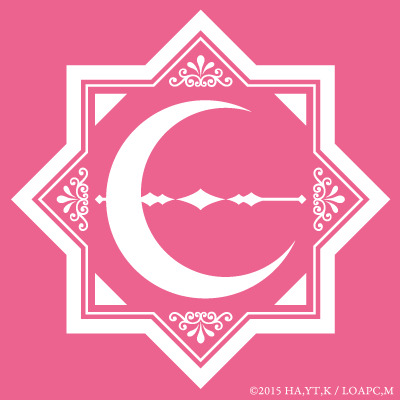
Also, funny thing, I was about to include deer antlers or something incorporated in one of her designs because:
“The Persian fallow deer (Dama dama mesopotamica), an ancient domesticate once thought extinct, was rediscovered in the late 20th century in Khuzestan Province, in the southern Zagros.”
Buuuuut I... forgot. Whoopsies, MY BAD.
Also keep an eye on the cypress. It'll come up again later. I know, I know, I'm asking you to put a pin on a bunch of things but I promise it'll all come together later.
(as a fun little aside, Farangis has emerald-coloured eyes and as I stated in Ranna's sheet, emeralds were said go be “a revealer of truths, they reputedly could cut through all illusions and spells, including the truth or falsity of a lover's oath” and they're associated with Venus/Aphrodite she is really beautiful and Aphrodite is the goddess of love and beauty and well this isn't all that significant in the grand scheme of things I just thought it was a funny coincidence— and what's really funny is that Aphrodite's divine domain and Artemis' no-romance policy is in conflicts alright alright I'll stop rambling about this now)
She is wearing a purple sash to signify where her loyalty lies, echoing both Arslan and Kazai, both people significant to her.
Her second outfit is akin to a hunting attire, more muted greens, not a whole lot of embellishments going on because I don't think she's wild about that, simple, functional, but still looks good on her. Not much to say symbolically in this one, only that here a raven feather features again attached to her raishal (crystal flute) on her necklace, and she is wearing the healers' badge here as well. And while the healers: badge specifically references Quercus castaneifolia, the chestnut-leaved oak, another species of oak is also significant to her by ways of being important to her homeland.
“Quercus brantii (covering more than 50% of the Zagros Mountains forest steppe ecoregion) is the most important tree species of the Zagros in Iran.”
Her homeland Khuzestan would be near the Zagros mountain range I believe— though I guess they're named the Nimruz mountains in Arslan Senki? I really need to brush up on my geography.
“Iranians use its seed in traditional medicine. Other useful products derived from oaks include fuel wood, charcoal and timber hardwood.”
They're also used in medicine!
I go into much more detail of why oak trees are used to symbolize the clan healers in Arslan's design sheet here, so I won't bore you by repeating it here again.
And OH I almost forgot about the designs on her boots. They're meant to be barley!
Forgive me for I won't be able to provide much in terms of proper quotes from articles and such, because when I looked up barley symbolism on Google I literally could not dodge the Bible stuff. All the info here is provided by a lovely French-speaking friend who went onto the French side of Google and hurled up a bunch of information for me.
@werewolfcoochie thank you SO MUCH for your invaluable aid. I couldn't have done this without you.
“Barley has been an important part of human culture due to is popularity as the most common grain used in the process of malting, which is essential for the production of beer, whiskey, certain candies, and sweet meal.”
And hey, while beer and whiskey don't equate wine, it's still alcohol and Farangis has like. God-tier alcohol tolerance.
Barley can also symbolize fertility, hope, abundance, and a good harvest— which definitely makes you think of the role the clan plays in the local agriculture.
“Historically, a society that is rich in barley can typically count on having a lot of food in total, so the crop can be connected with general prosperity and overall welfare.”
×
“Barley can potentially have a lot of religious significance for different people. It can also be seen as a general sign of hope and a desire for abundance and a good, healthy life.
It is the most common grain used for the making of arguably the most popular form of alcohol in the world.”
It also seems to have associations with medicine and magecraft, which makes sense since those two things were often bundled together historically.
Barley was also used in ritualistic medicine in England. Witches would cook and then let barley evaporate in the room of the sick person, and then draw on them magic symbols using the uncooked one. It was also said to help with tooth pain.
The witch Circe used it in a potion to turn Ulysses' companions into pigs. Some people also burned barley on Apollo's shrines.
“Circe is an enchantress and a minor goddess in ancient Greek mythology and religion. In most accounts, Circe is described as the daughter of the sun god Helios and the Oceanid nymph Perse. Circe was renowned for her vast knowledge of potions and herbs. Through the use of these and a magic wand or staff, she would transform her enemies, or those who offended her, into animals.”
Eyyy, a sorceress! Though Helios is not Apollo, they're both associated with the sun. It doesn't mean much, I just thought it was fun.
Demeter was also linked to barley. After Demeter lost her daughter Persephone, some humans tried to cheer her up by giving her wine, but she refused, asking for alcohol made from barley instead. And as Demeter is a goddess of nature responsible for all plant growth including crops, it would make sense for her to be associated with barley.
In Middle Ages, there was a form of divination using barley called alphitomancy.
In India, people use barley for sacrifices and private life ceremonies like births, marriages and so on— and some shamans use it to curse people.
In Ancient Egypt, Osiris was linked to cereals in general, and he was always depicted with barley. Ancient egyptians would make little statues and plant barley inside them. The growth of barley symbolizes the rebirth of Osiris after being killed by his brother Seth.
“Osiris is the god of fertility, agriculture, the afterlife, the dead, resurrection, life, and vegetation in ancient Egyptian religion.”
(I'll get to all the death stuff eventually, I promise.)
They also used barley against inflammation and also as divination tool to know the sex of an unborn child, and modern tests have shown that barley can be used to determine the sex of a baby with 70-75% effectiveness. Just a fun tidbit!
Okay, I thought I didn't have much to say about the second outfit. Uhhhh, oops?
And now finally we move onto the third. Are y'all still alive yet?
It's the ceremonial attire she would wear as a mage-musician during celebrations and ceremonies, and though it bears similarities to the spirit dancers' clothes, there are also a couple little differences! The silhouette is different, and the musicians tend to wear one of the two colours (blue or white) rather than clothes that split between them. Farangis happened to favor white.
Aaaaaand the willow! Promised I'd get to it, didn't I? Get ready, get ready, we're about to take a trip into the underworld.
Don't be alarmed.
“A large tree with long, flowing branches and leaves, the willow tree often symbolizes flexibility and adaptability. The limber and supple nature of its extremities means it bends to accommodate and withstand strong winds and adverse weather. Many, therefore, see it as inspiring and symbolic of humans’ capability to withstand hardship, loss, and difficult emotions. Thanks to its long life and the ease with which new trees can be rooted from cuttings, the willow tree is also seen as a survivor and a symbol of rebirth.”
×
“The willow tree is sometimes referred to as the "weeping willow." This name comes from the way raindrops run down its long leaves, making it look like the tree is crying. The weeping willow is therefore associated with grief and mourning in many cultures.”
×
“A willow’s drooping branches and leaves are seen as a symbol of letting go. In many cultures, willows are planted near gravesites as a way to honor the dead.”
×
“The willow tree symbolism of grief may be due in part to its ability to thrive in wet conditions. This hardiness has led to the tree being seen as a symbol of resilience in the face of adversity.”
×
“Dreaming of willow trees can mean many things, but their main messages are feelings of rigidness, the need to move on, and feeling unsafe.”
Farangis endured jealousy and ostracization from her peers in the temple due to her beauty and skill, and though she stayed loyally until she was sent to find Arslan in canon, she decided to leave the temple to join the clan in this AU.
She was sent to the temple because her parents died and there presumably was nobody left to take her in— and having to deal with grief on top of a new environment seemingly very hostile to you can't be easy in the slightest. And here we get to the theme of loss— she lost her parents and struggles to deal with the fact before she joined the clan. All the death/afterlife associations I've built up until now all culminate in this grief of hers, those intense and complicated emotions that ultimately resulted in her leaving the temple (“letting go” of the expectations placed on her by the adults, by her parents, letting go of a toxic environment, no longer bound to her parents' wish) to seek out a “rebirth” under Eihon's guidance. No longer was the temple a place of refuge and safety for her, and it's debatable whether it ever was.
And regarding rebirth, you may have noticed a lot of clan-style garments go right-over-left which is usually opposite to how many cultures around the world do it: right-over-left is reserved for the dead. The people who join the clan are functionally dead to the world and the places they came from— the runaway slaves are practically “dead” to their slavers, runaway children and abuse victims are “dead” to their families and abusers, by virtue of them disappearing off the face of the earth and being impossible to find again. And many, particularly ones who had negative or complicated relationships with their previous identities/names and families often opt to change their names, making the death and rebirth a bit more literal.
Farangis and Gieve chose to keep their names because it wasn't their families/parents they had an issue with, and still love them despite it all.
“Most symbolism surrounding willow trees comes from their graceful appearance. Their lightweight leaves, long branches, and protective caves inspire many and hold a powerful message.”
×
“The willow tree originates from China, and in Ancient China, people believed that willow branches could ward off evil. They were often carried around or placed at doorways to keep evil spirits away. The concept of the willow tree bringing good luck and protecting against evil is also prevalent in countless cultures across the world.”
×
“Willow branches also brought protection in Ancient Greek mythology, although willow also symbolized power in general. Orpheus, the bringer of song, carried willow wood with him to protect against evil in the underworld. Hecate, the goddess of witchcraft, also used a wand made out of willow. Willow is connected to music in Greek mythology — the harp that Apollo gifted Orpheus was made of willow wood.”
×
“In some cultures, people plant willows near homes to keep away evil spirits. Willow branches are often used in magical rituals and spells to ward off negative energy. Willow trees also create a ‘barrier’ if they are allowed to grow down to the ground. People have sat inside these barriers during warm months to protect themselves from the sun.”
×
“The willow was a powerful tree that symbolizes healing, strength, and functionality.”
×
“The willow tree is often seen as a symbol of peace. This is likely because willow trees are known for their calming and serene qualities. The branches of these trees are light enough to simply sway in the wind. The soft rattle of the leaves also creates a calming effect that evokes peace in just about anyone.”
These just scream Farangis to me. Also, Hecate is the goddess of boundaries, transitions, crossroads, magic, the New Moon, necromancy, and ghosts— and associated with all of the above plus the night, protection from witchcraft, and knowledge of herbs and poisonous plants. The “transitions and crossroads” could be taken to represent the period between her meeting the clan people and choosing to join them, stuck between two paths before steeling herself to choose one.
And of course, they also have medicinal properties!
“In ancient times, willows were used for their medicinal properties. Their leaves and bark are said to help with inflammation and other ailments.”
Arrows were also apparently made out of willow branches in some cultures, which is fitting considering that Farangis is a skilled archer.
And at the bottom of the white coat, you'll see elaborate patterns adorning the side slits— they're supposed to be like, very highly stylized renditions of cypress trees though I certainly got carried away and now I'm not sure they look like cypresses anymore. Ha, told you I'd eventually get to them!
“In the words of the Shahnameh, cypress represents a single-minded, professional and wise man. In ancient Iran, at Yalda night, a tree called Yalda tree was decorated, which was generally made of cypress and pine trees. It is said that the decoration of cypress and pine in Christmas was adapted from ancient Iran, because the Iranians looked at these two trees, especially the cypress, as a symbol of resistance against darkness and cold, and they stood in front of the cypress on the first day of January. And they vowed to be strong and stable until the next year and plant another cedar sapling.
In the classical tradition, the cypress was associated with death and the underworld.”
I have already talked about all the reasons I decided to rope in death and resilience in sections above!
“In Greek mythology, besides Cyparissus, the cypress is also associated with Artemis and Hecate, a goddess of magic, crossroads and the underworld. Ancient Roman funerary rites used it extensively.
In Jewish tradition, the cypress was held to be the wood used to build Noah's Ark and The Temple, and is mentioned as an idiom or metaphor in biblical passages, either referencing the tree's shape as an example of uprightness or its evergreen nature as an example of eternal beauty or health. It is popular in modern Israeli cemeteries, with contemporary explanation being that its shape resembles a candle and its being an evergreen symbolized the immortality of the soul.”
×
“The tree is one of the oldest symbols of mourning. In fact, ancient Greeks and Romans referred to the cypress as the "mournful tree" for this reason. Adherents of Christianity and Islam historically planted cypress near burial sites and cemeteries for protection against evil spirits.”
So... there you have it! Farangis' design sheet! I hope y'all liked it, Gieve is slated to be next though I think I'll probably end up taking a good long break first.
#arslan senki#the heroic legend of arslan#heroic legend of arslan#wolfpack au#winds of wolfsong#farangis#rotten egg's shitty art#the character design sheet saga#symbolism#how fucking long is this post???#long post#just in case#so yeah there you go!#hope y'all enjoyed this as much as I enjoyed creating both the designs and the post#it is currently... *checks clock* 3:40am as of uploading#I have been typing away at this post since like 1am#I'm very tired and I'll head to bed now
31 notes
·
View notes
Text
Your eyes are inscribed in my flesh.
Alejandra Pizarnik, The Galloping Hour: French Poems; from ‘I check for you in the wind’, tr. Patricio Ferrari & Forrest Gander
360 notes
·
View notes
Text
I have long believed that there has never been a career, in any fictional universe, as inherently thankless, fruitless, and utterly hopeless as that of the Hylian Archeologist.
This only reinforces that to me. I unironically love this explanation. I love that it comes alongside Zelda being a Hylian archeologist alongside multiple supporting characters.
“Sometimes the things you study abruptly disappear. It just happens. You try intensely to understand what they are before that happens, because no matter how much you understand any given subject there will always be far, far more mysteries than you can even comprehend. This probably wasn’t the first time and it won’t be the last. How many ancient civilizations came before this that likewise disappeared without a trace, long before you or anyone you know was ever born? You don’t know. You will never know. Those records probably disappeared too.”
#loz#zelda#legend of zelda#tears of the kingdom#totk#this is minor enough I don’t think it needs spoilers#no but seriously this… genuinely explains a lot to me?#like of course there’s no record of Wind Waker or the Minish they probably disappeared too#how old is Hyrule? legitimately unknowable and unfathomable. too many records have VANISHED FROM EXISTENCE.#this is I’m sure infuriating if you hadn’t long since passed through the stages of grief looking at the Zelda timeline into acceptance#but I’ve genuinely been incorporating Unraveled’s Zelda Monopoly Time Break explanation into my headcanon because why the fuck not#so like. ‘everyone just rapidly comes to terms with things when the ancient tech spontaneously vanish’ just checks out to me.#except sometimes it doesn’t because Purah clearly made the new towers out of the old ones#and has a couple dead Guardians as decorations but like.#don’t worry about it!
17 notes
·
View notes
Text
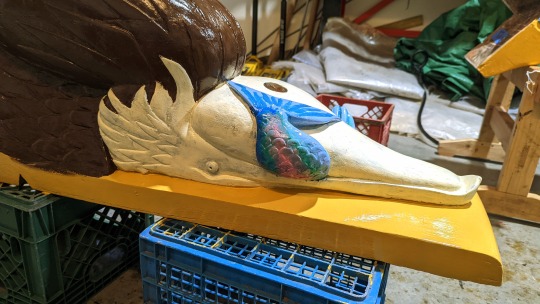

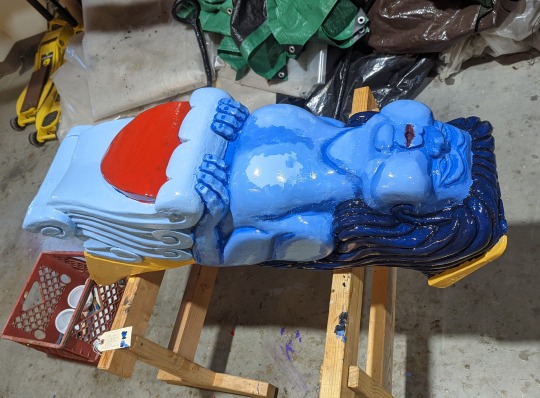
Made some good progress today!
#shipyard stuff#painting projects#You can see my little paint color reference tag from when I painted the other wind goddess there#I'm so glad I made that since I can't exactly go check the one on the boat while I'm working#The fish will be another rainbow trout to match the trout that the eagle has
8 notes
·
View notes
Text
just finished mistborn the final empire and... it's unclear to me how you guys kept going after this
#like??????#i had to google just to check if it was true and IT WAS???#and i SAW there are more deaths#i cannot do this#this type of heartbreak i cannot deal with#he was my beloved#i now think wind and truth will leave NO ONE alive you guys im so scared#how can anyone start branderson with this slap of a book i would have never made it to stormlight#vin is everything i love her#what a fucking depressing friday#mistborn: the final go fuck yourself#mistborn
9 notes
·
View notes
Text
So we can all agree that the Tears of the Kingdom Rito Boss blows most of the other bosses in BotW/TotK out of the water right
#Tears of the Kingdom#Tears of the Kingdom spoilers#spoilers#Colgera#Rito VIllage#just the whole build up to it#the music!#having Tulin with you#the fact that you can DIVE into the weak points!!!#which i didn't know until i checked a youtube comment lmao#the fact the fight uses all of the stuff you've used bfore to make it one big test of what you've learned#YOU'RE FIGHTING IT ON A GIANT BOAT#which i guess is also a wind waker reference noice
44 notes
·
View notes
Note
What are some things you like the most about the sea?
I was once in love with a girl who reminded me of the sea and now every sea in the world is her.
#the sea#no other reason to be honest#but then there's the ocean#the ocean is a whole different thing#the vastness of it#when the wind vaguely smells of sea salt in november in moscow#and is unusually high (I don't know if there's a term for it. you can see when it's the same on the ground and in the clouds)#(it's not normally like that)#and you check the wind map#and yes there's a single wind mass stretching from norway to the midlle of the continent#the embodiment of distance#also#sitting on a mountaintop in west ireland#being knocked off your feet by the wind#watching weather for the next week coming from over the ocean#clouds forming#those smell of ice and eternal spring#and then going back to dublin the next morning and watching it arrive there too#just generally the presence of something enormous always looming over the island#even if it's a 4 hour drive away you still sense it#I guess I like the ocean because of the wind#and how sky reflects the ocean#(not the other way around as is often thought)
10 notes
·
View notes
Text
how the fuck do you have a whole region of the country where it doesn't storm
that doesn't make sense
weather doesn't do that
#HI I JUST FOUND OUT THE PNW HAS RAIN BUT NOT THUNDERSTORMS#HOW THE FUCK DOES THAT HAPPEN#RAIN ALMOST ALWAYS COMES WITH A LIGHTSHOW AND A CONCERT HERE#how do y'all just... NOT experience the fury of the skies every couple of weeks#the strange magic that keeps you safe standing on the porch while you watch the trees bend and twist#the terror of hearing a tree snap outside your front door#the wonder of watching lighting spiral through the clouds#dancing streaks of purple and yellow and white and blue#the knowledge that You Are Very Small and Very Mortal and the World Is Very Large#how do y'all not have that#what foolish acts of hubris fill your reckless hearts if not the urge to run headlong into the wind and laugh#what phenomenal acts of uncaring power keep that hubris in check if not watching a tree the size of your house tip over and snap like a twi
15 notes
·
View notes
Text
oooohohoh baby im back in business i got into a new area to explore and i got a bunch of new green things to click on and find items in and i talked to an incredibly shady mob boss and he gave me. a giant novelty check? to pay my rent with? so i'm totally in his pocket and that's not looking good BUT i've still got kim with me and kim thinks it's important that i don't sleep on the streets, so i'm proving to him that i can be a professional by doing the field autopsy with him at 9pm in the dark . also i finally leveled up my volition so i might not like . suffer dizzy spells of low morale every time i remember what dire straits im in. AND I LEARNED MY NAME jesus yeah that was a big one. the mob boss used it so now i know more or less that i have a name. but that was while having a panic attack about my lost gun. so ya win some ya lose some
#so many more tasks now tho#every time i accomplish three i wind up with six more#my favorite tasks are the secret ones bc i FEEL like ive checked something off the list#but by far the very best part of the game is clicking on green things. it's like an advent calendar it's great i love it#i love you green things#i dont love the ominous worldbuilding hints that seem to be suggesting that even if i do solve the mystery#everything will go very bad anyway. but hey . ive got kim. and ive got my snakeskin boots#disco elysium#so so so sad the first time i hear my name in my current fragile state is when a mob boss is mocking me . so sad
11 notes
·
View notes